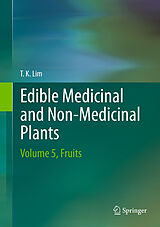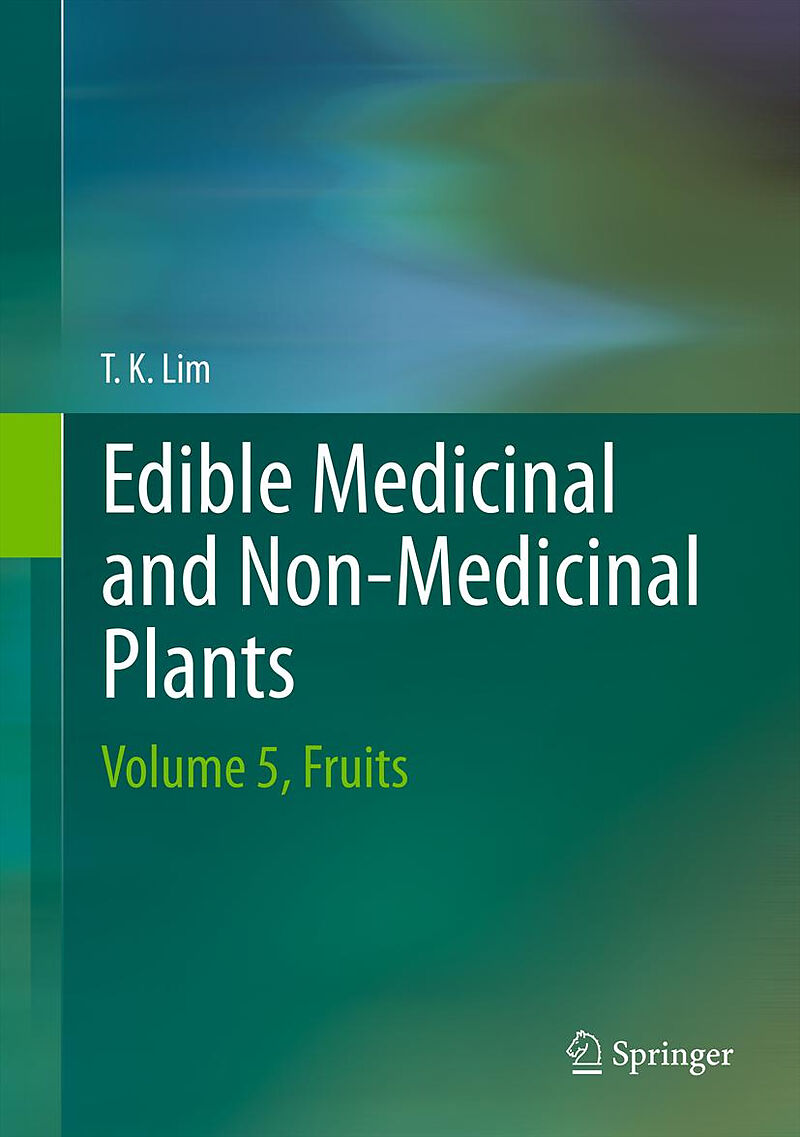Edible Medicinal And Non-Medicinal Plants
Einband:
Fester Einband
EAN:
9789400756526
Untertitel:
Volume 5, Fruits
Autor:
T. K. Lim
Herausgeber:
Springer Netherlands
Auflage:
2013
Anzahl Seiten:
956
Erscheinungsdatum:
03.02.2013
ISBN:
9400756526
This fully referenced resource covering current knowledge of the medicinal and nutritional properties of fruits forms part of Springer's multi-volume corpus on the plant world. It focuses on selected species including Lythraceae and Xanthorrhoeaceae .
This book continues as volume 5 of a multicompendium on Edible Medicinal and Non-Medicinal Plants. It covers edible fruits/seeds used fresh, cooked or processed as vegetables, cereals, spices, stimulant, edible oils and beverages. It covers selected species from the following families: Apiaceae, Brassicaceae, Chenopodiaceae, Cunoniaceae, Lythraceae, Papaveraceae, Poaceae, Polygalaceae, Polygonaceae, Proteaceae, Ranunculaceae, Rhamnaceae, Rubiaceae, Salicaceae, Santalaceae, Xanthorrhoeaceae and Zingiberaceae. This work will be of significant interest to scientists, medical practitioners, pharmacologists, ethnobotanists, horticulturists, food nutritionists, botanists, agriculturists, conservationists, lecturers, students and the general public. Topics covered include: taxonomy; common/English and vernacular names; origin and distribution; agroecology; edible plant parts and uses; botany; nutritive/pharmacological properties, medicinal uses, nonedible uses; and selected references.
Referenced up-to-date-information on nutritive and medicinal properties Common and vernacular names to help in plant identification Medical and scientific glossaries
Autorentext
TK Lim (Tong Kwee Lim) obtained his Bachelor and Masters in Agricultural Science from the University of Malaya and his PHD (Botanical Sciences) from the University of Hawaii. He worked in the University of Agriculture Malaysia for 20 years as a lecturer and Associate Professor; as Principal Horticulturist for 9 years for the Department of Primary Industries and Fisheries, Darwin, Northern Territory; 6 years as Manager of the Asia and Middle East Team in Plant Biosecurity Australia, Department of Agriculture, Fisheries and Forestry, Australia; and 4 years as Research Program Manager with the Australian Centre for International Agriculture Research (ACIAR), Department of Foreign Affairs and Trade, Australia before he retired from public service. He has published over a hundred scientific papers including several books: "Guava in Malaysia: Production, Pest and Diseases", "Durian Diseases and Disorders", "Diseases of Mango in Malaysia", chapters in books, international refereed journals, conference proceedings (as editor) and technical bulletins in the areas of plant pathology, crop protection, horticulture, agronomy and quarantine science. He was also a reviewer of scientific papers for several international scientific journals. As Principal Horticulturist in Darwin, he and his team were instrumental in establishing the horticultural industry in the Northern Territory, Australia, especially on tropical fruits, vegetables, culinary herbs, spices / medicinal herbs and tropical flowers. During his tenure with Plant Biosecurity, he led a team responsible for conducting pest risk analyses and quarantine policy issues dealing with the import and export of plants and plant products into and out of Australia for the Middle East and Asian region. During his time with ACIAR, he oversaw and managed international research and development programs in plant protection and horticulture covering a wide array of crops that included fruits, plantation crops,vegetables, culinary and medicinal herbs and spices mainly in southeast Asia and the Pacific. In the course of his 4 decades of working career he has travelled extensively worldwide to many countries in South Asia, East Asia, southeast Asia, Middle East, Europe, the Pacific Islands, USA and England, and also throughout Malaysia and Australia. Since his tertiary education days he always had a strong passion for crops and took an avid interest in edible and medicinal plants. Over the four decades, he has taken several thousands of photographs of common, known and lesser known edible, medicinal and non-medicinal plants, amassed local literature, local indigenous knowledge, books, and has developed and established close rapport with many local researchers, scientists, growers and farmers during the course of his work and travels. All relevant available and up-to-date information collated on more than a thousand species of edible, medicinal and non-medicinal plants will be provided in a comprehensive reference series fully illustrated with coloured images to help in plant identification. This work will cover scientific names, synonyms, common and vernacular names, origin and distribution, agroecology, edible plant parts and uses, plant habit /description, nutritive and medicinal value, other uses and selected current references. Additional information is provided on the medicinal uses and pharmacological properties of the plants. This work will be of significant interest to scientists, researchers, practitioners (medical practitioners, pharmacologists, ethnobotanists, horticulturists, food nutritionists, agriculturists, botanists, herbalogists, herbologists, naturalists, conservationists, extension scientists, teachers, lecturers), students and the general public.
Klappentext
This book continues as volume 5 of a multi-compendium on Edible Medicinal and Non-Medicinal Plants. It covers edible fruits/seeds used fresh, cooked or processed into other by-products, or as vegetables, cereals, spices, stimulant, edible oils and beverages. It covers selected species from the following families: Apiaceae, Brassicaceae, Chenopodiaceae, Cunoniaceae, Lythraceae, Papaveraceae, Poaceae, Polygalaceae, Polygonaceae, Proteaceae, Ranunculaceae, Rhamnaceae, Rubiaceae, Salicaceae, Santalaceae, Xanthorrhoeaceae and Zingiberaceae. The edible species dealt with in this work include to a larger extent lesser-known, wild and underutilized crops and also common and widely grown crops. To help in identification of the plant, edible parts and food products about 200 coloured illustrations are included. As in the preceeding four volumes, topics covered include: taxonomy (botanical name and synonyms); common English and vernacular names; origin and distribution; agro-ecological requirements; edible plant parts and uses; plant botany; nutritive, medicinal and pharmacological properties with up-to-date research findings; traditional medicinal uses; other non-edible uses; and selected/cited references for further reading. This volume has separate indices for scientific and common names; and separate scientific and medical glossaries.
Inhalt
Introduction.- Apiaceae.- Brassicaceae.- Chenopodiaceae.- Cunoniaceae.- Lythraceae.- Papaveraceae.- Poaceae.- Polygalaceae.- Polygonaceae.- Proteaceae.- Ranunculaceae .- Rhamnaceae.- Rubiaceae.- Salicaceae.- Santalaceae .- Xanthorrhoeaceae.- Zingiberaceae.- Medical Glossary.- Scientific Glossary. Common Name Index.- Scientific Name Index.

Leider konnten wir für diesen Artikel keine Preise ermitteln ...
billigbuch.ch sucht jetzt für Sie die besten Angebote ...
Die aktuellen Verkaufspreise von 6 Onlineshops werden in Realtime abgefragt.
Sie können das gewünschte Produkt anschliessend direkt beim Anbieter Ihrer Wahl bestellen.
Loading...
Die aktuellen Verkaufspreise von 6 Onlineshops werden in Realtime abgefragt.
Sie können das gewünschte Produkt anschliessend direkt beim Anbieter Ihrer Wahl bestellen.
| # | Onlineshop | Preis CHF | Versand CHF | Total CHF | ||
|---|---|---|---|---|---|---|
| 1 | Seller | 0.00 | 0.00 | 0.00 |
